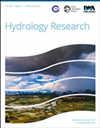Surface-groundwater exchange between a wetland, sandur, and lava field in southeastern Iceland
IF 2.4
4区 环境科学与生态学
Q2 Environmental Science
引用次数: 0
Abstract
In May 2019, over 50 springs were identified at a sandur-lava field–wetland complex in Southeast Iceland and a subset was selected for further investigation including monitoring water levels, discharge, and water chemistry. Between May and September 2019, springs at the study site had relatively stable water levels and temperatures (4–5 °C), although heavy rains (>10 mm) corresponded with increased water levels and/or temperatures at some springs. Together, the water level, temperature, and stable isotope data suggest that the springs at the study site are fed by older groundwater from an aquifer that is recharged by precipitation. Spikes in water level indicated that at least one spring at the edge of the sandur also received floodwater and shallow subsurface flows from the glacial-fed Brunná River. One wetland spring was further monitored over the water year (October 2019 to October 2020). Like other springs, water levels and temperatures remained relatively stable, fluctuating with inputs of precipitation. Longer-term studies will be needed to gain an improved understanding of seasonal spring vulnerability to climate change and their role in the functioning of a coastal wetland in Southeast Iceland.冰岛东南部湿地、沙都尔和熔岩场之间的地表地下水交换
2019年5月,在冰岛东南部的一个桑杜尔-熔岩场-湿地复合体中发现了50多个泉水,并选择了一个子集进行进一步调查,包括监测水位、流量和水化学。2019年5月至9月期间,研究地点的泉水水位和温度相对稳定(4-5°C),尽管暴雨(10 - 10毫米)与一些泉水的水位和/或温度升高相对应。总之,水位、温度和稳定同位素数据表明,研究地点的泉水是由降水补充的含水层中较老的地下水提供的。水位的峰值表明,沙砾边缘至少有一个泉水也接收了来自冰川的布伦纳河的洪水和浅层地下水流。在水年(2019年10月至2020年10月)期间对一个湿地泉进行了进一步监测。像其他泉水一样,水位和温度保持相对稳定,随着降水的输入而波动。需要进行更长期的研究,以更好地了解季节性春季对气候变化的脆弱性及其在冰岛东南部沿海湿地功能中的作用。
本文章由计算机程序翻译,如有差异,请以英文原文为准。
求助全文
约1分钟内获得全文
求助全文
来源期刊

Hydrology Research
Environmental Science-Water Science and Technology
CiteScore
5.30
自引率
7.40%
发文量
70
审稿时长
17 weeks
期刊介绍:
Hydrology Research provides international coverage on all aspects of hydrology in its widest sense, and welcomes the submission of papers from across the subject. While emphasis is placed on studies of the hydrological cycle, the Journal also covers the physics and chemistry of water. Hydrology Research is intended to be a link between basic hydrological research and the practical application of scientific results within the broad field of water management.
 求助内容:
求助内容: 应助结果提醒方式:
应助结果提醒方式:


